“Coach, I Was Open”: Identifying the players who could see more targets in Week 9
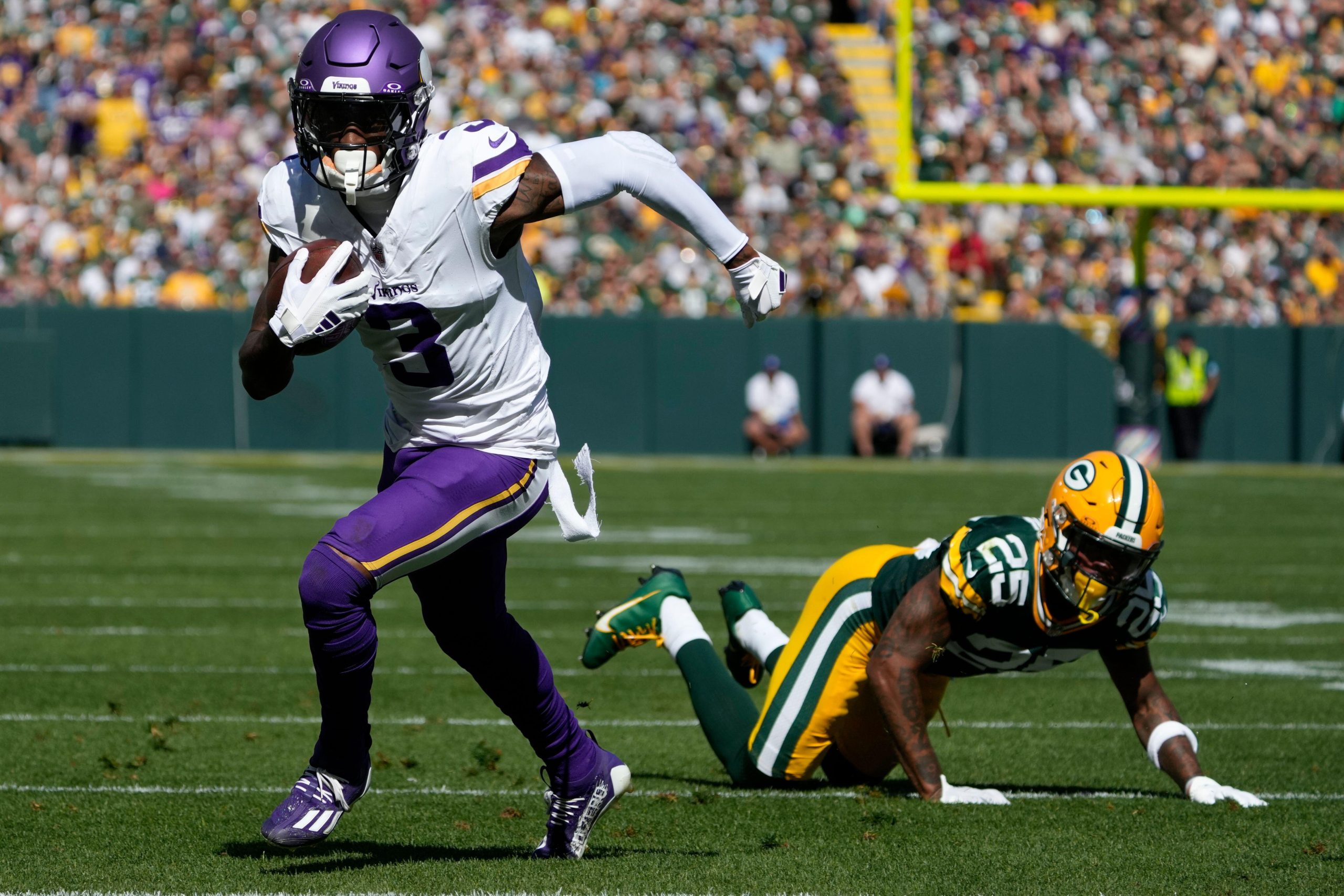
2Y7CBEY Minnesota Vikings wide receiver Jordan Addison (3) runs to the end zone for a touchdown past Green Bay Packers cornerback Keisean Nixon (25) during the first half of an NFL football game Sunday, Sept. 29, 2024, in Green Bay, Wis. (AP Photo/Morry Gash)
By
Joseph Bryan
• Unlock your edge with a PFF+ subscription: Get full access to all our in-season fantasy tools, including weekly rankings, WR/CB matchup charts, weekly projections, the Start-Sit Optimizer and more. Sign up now!
Estimated reading time: 6 minutes
Welcome to the latest installment of “Coach, I Was Open,” my ongoing statistics series, where I build and refine a model to predict targets for every route in every NFL game.
In my first article, we discussed creating the foundational “predicted targets” model. The second article focused on refining this model and introduced powerful derivatives: “share of predicted targets” and “share of predicted air yards” (these derivatives have shown to be significantly more stable and predictive than their counterparts). In the third article, we explored the model’s practical implications and how the predicted target probability was developed. Last week, we tweaked the model to account for the timing of NFL offenses and defenses.
Let’s review the model’s performance in Week 8 and identify some takeaways for Week 9.
My model correctly identified several Week 8 breakout games:
- Zay Flowers: 7 Catches, 115 yards, 0 TD
- Darius Slayton: 4 Catches, 108 yards, 0 TD
- Ladd McConkey: 6 Catches, 111 yards, 2 TD
- Courtland Sutton: 8 Catches, 101 yards, 0 TD
- DeVonta Smith: 6 Catches, 85 yards, 1 TD
- Noah Brown: 3 Catches, 73 yards, 1 TD
- Sam LaPorta: 6 Catches, 48 yards, 1 TD
The concept behind this model centers on the fact that up to five players can run a route on any given play, but only one player can receive the target. And sometimes, no pass is attempted at all.
However, this doesn’t mean other players didn’t “earn” a target. My model is designed to predict whether a player should have been targeted. This approach enables us to create highly predictive metrics, such as “share of predicted targets” and “share of predicted air yards,” both of which are significantly more stable and predictive than their “actual” counterparts.
The theory is that after reviewing the film each week, teams identify which players were open but didn’t get the ball and then adjust their game plan to involve those players more in the following week.
Season Leaders in “Share of Predicted Targets”
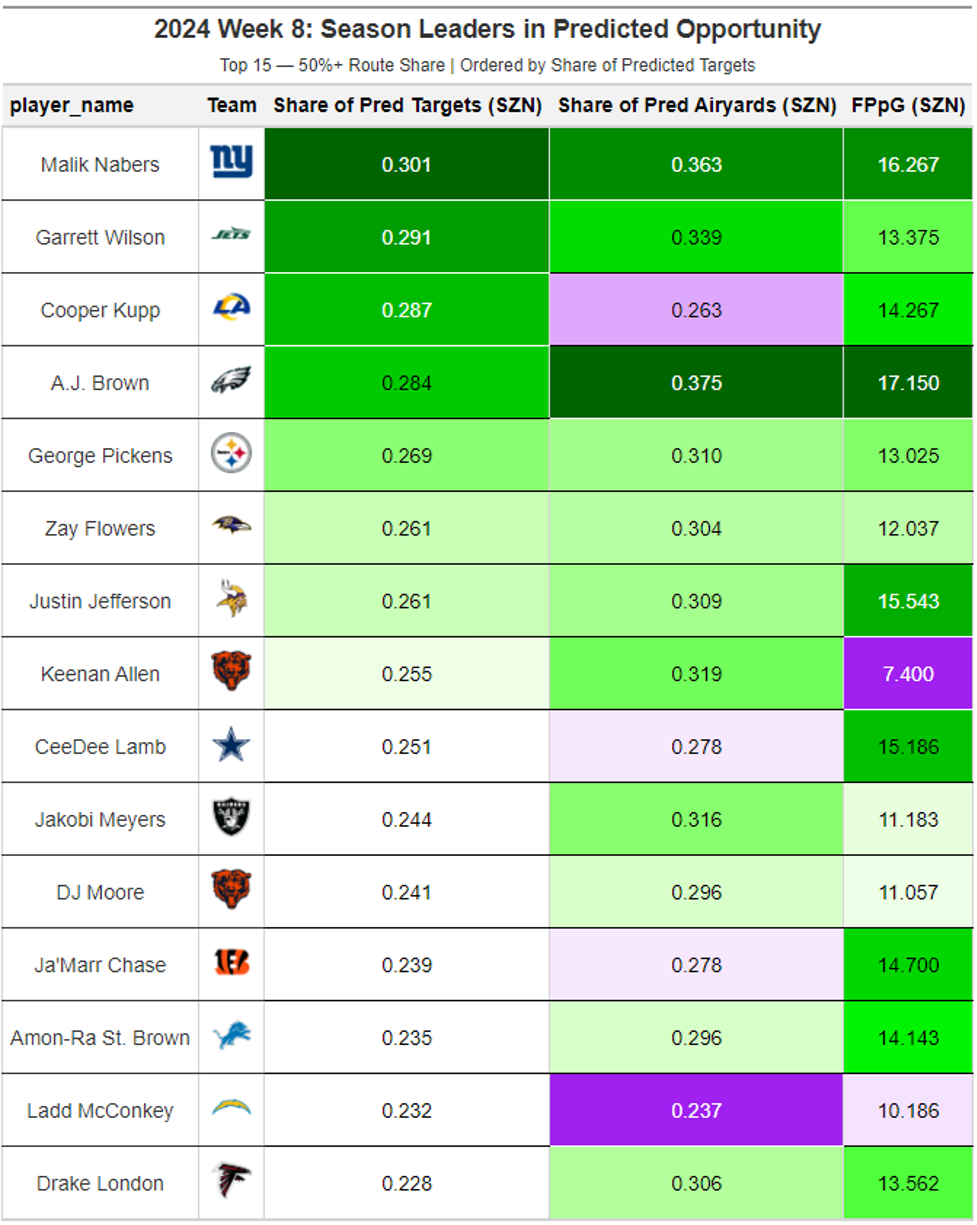
Keenan Allen still has plenty of juice left. Notably, he’s now earning a significant share of “predicted air yards,” which is unusual for him. Allen is also a route-based hero this week. I fully expect an explosive performance from him soon, as I did with Ladd McConkey last week.
Jakobi Meyers finds himself in elite territory for “share of predicted targets” and boasts a high “share of predicted air yards,” highlighting the value of his routes.
The Bears now have two top-15 receivers in “share of predicted targets,” which bodes well for Caleb Williams and the team’s future.
As I mentioned last week, Malik Nabers is in truly special territory. This is likely the weakest offense he’ll ever play in, so expect his potential to shine even brighter.
Week 8 “Coach, I Was Open” Table
This table highlights players who excelled at getting open in Week 8 but didn’t receive as many targets as expected. The “Week 8 TS Diff” column shows the difference between their actual target share and their “share of predicted targets.” The larger the negative value, the greater the discrepancy.
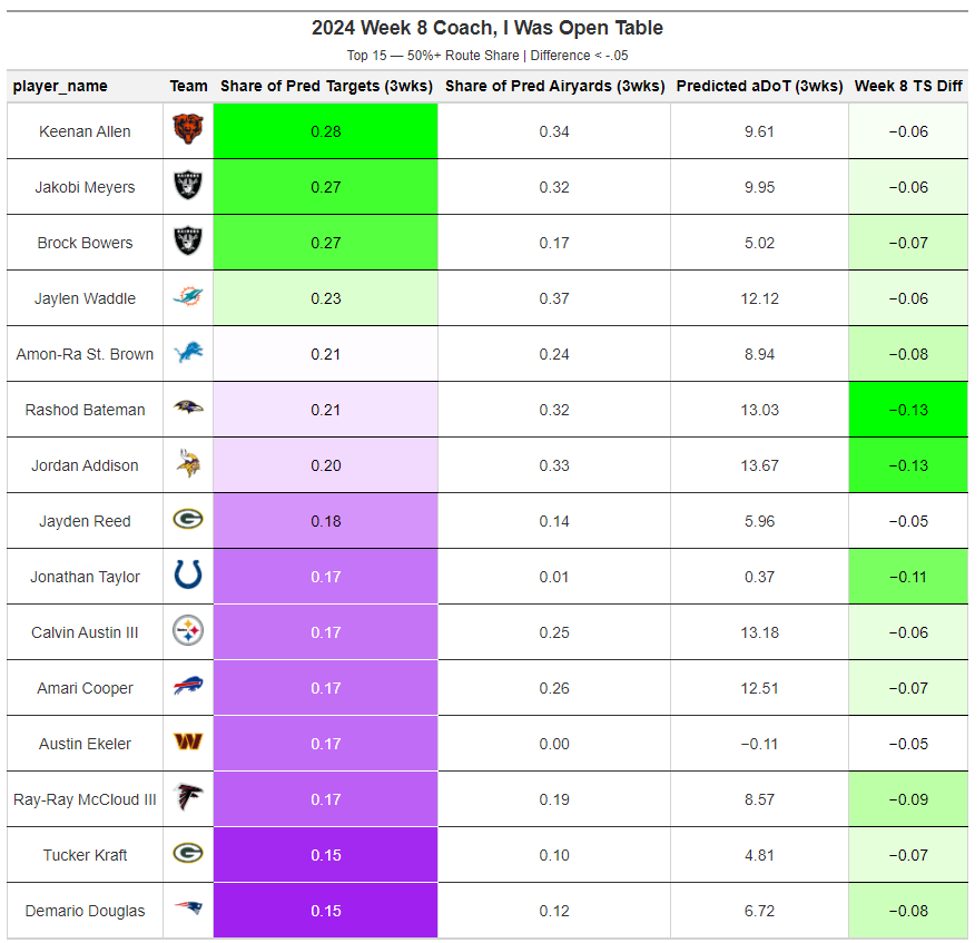
Bateman, Addison and Taylor each posted double-digit differences in their Week 8 Target Share Diff. Normally, Bateman would be primed for a spike in targets next week, but with the arrival of Diontae Johnson, his outlook is less certain. Bateman ran 15 routes with over a 30% chance of being targeted but only saw 3–5 actual targets, depending on how they’re counted.
Addison had a target probability above 30% on 13 occasions in Week 8 but received only three targets. He also runs the deepest route tree of the group, with a Predicted aDoT of 13.67, making his targets especially valuable when they come his way.
Taylor consistently got open, and with Anthony Richardson benched and the Colts facing the Vikings in Week 9 (who run two-high safety looks at the league’s highest rate), he’s likely to see an increase in targets.
Overall, any player on this list is likely to show up in film review with a strong case for more actual targets in Week 9.
Interesting note: In Week 7, Sutton had an extreme situation with 13 routes boasting a 30%-plus target probability, yet he received only one target (which didn’t count). In Week 8, the player with the most “extreme” situation in terms of missed targets was Jonathan Taylor, who ran four routes with a 30%-plus target probability but garnered only one target. This highlights just how unusual Sutton’s Week 7 target performance was.
Week 8 Review: (Reminder: actual targets in my model can include penalties, so target counts may not match other datasets.)
TE Brock Bowers
- Predicted Targets: 7.7
- Actual Targets: 5
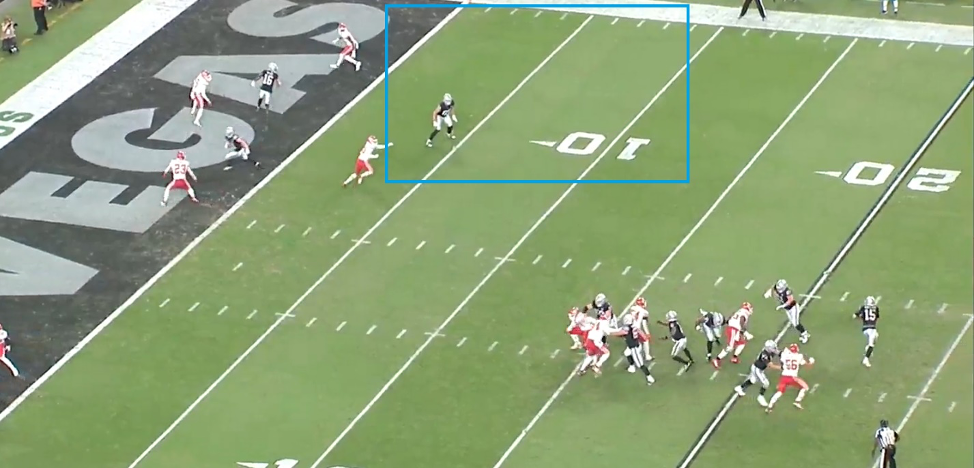
Bowers had five instances with a target probability above 30% where he didn’t receive the ball, his highest count all season.
On one play, Bowers had a 42% target probability while QB Gardner Minshew was rolling out in his direction. If Minshew had trusted himself and Bowers in that situation, Bowers would have had a good chance of scoring a touchdown if he broke a tackle. Instead, Minshew scrambled and ended up with no gain. DJ Turner scored on the following play, but this was ultimately a suboptimal decision by Minshew.
WR Jordan Addison
- Predicted Targets: 6.7
- Actual Targets: 3
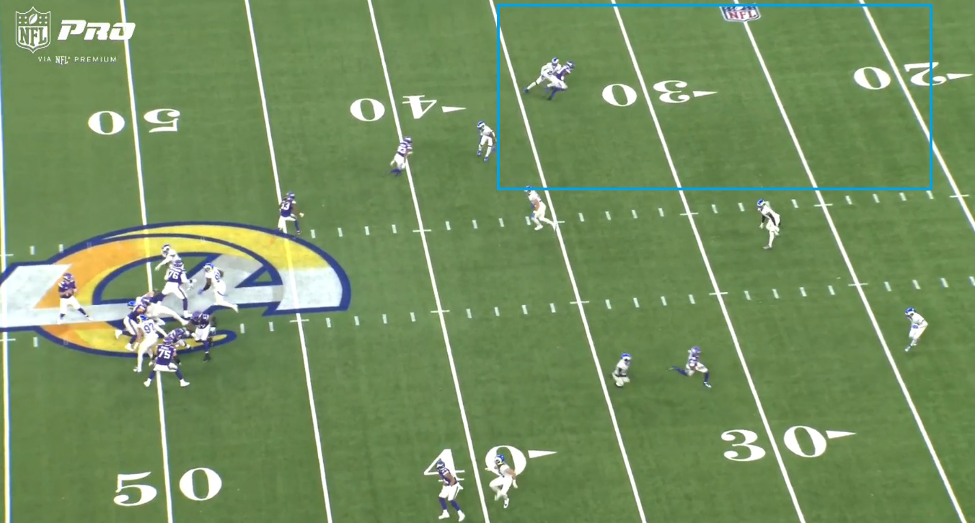
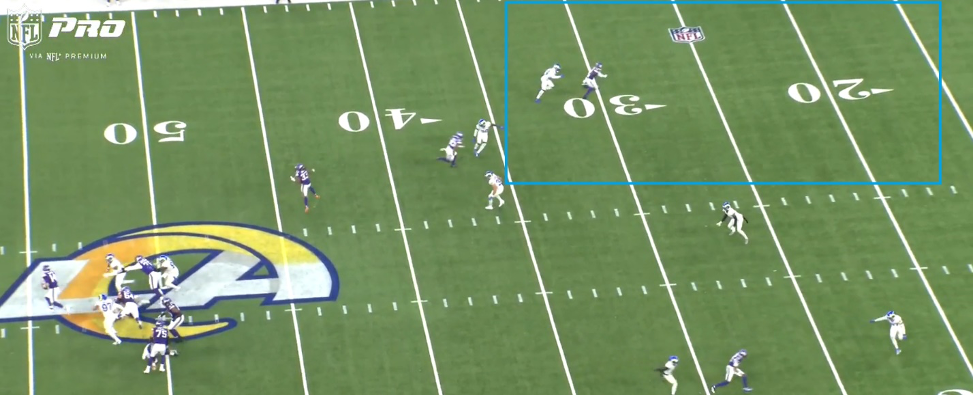
This time, I’ve included two screenshots for additional context. On Addison’s highest target-probability play (nearly 70%), he beat his defender and ended up wide-open.
Sam Darnold was pressured on the play. In my opinion, Darnold could and should have thrown the ball as soon as Addison was even with his defender before the pressure reached him. Instead, Darnold takes a 14-yard sack. This play illustrates how quarterback decisions can impact a receiver’s actual target opportunities in more nuanced ways. Additionally, Aaron Jones was wide open for a checkdown with a 20% target probability.
For more NFL stats and analysis, follow Joseph on Twitter/X.





